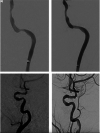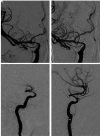Transcarotid artery revascularization (TCAR) stenting or angioplasty for intracranial carotid artery stenosis: Case series and novel application
- PMID: 35331034
- PMCID: PMC10399509
- DOI: 10.1177/15910199221090724
Transcarotid artery revascularization (TCAR) stenting or angioplasty for intracranial carotid artery stenosis: Case series and novel application
Abstract
Background: Carotid artery stenting is associated with a higher rate of stroke compared to carotid endarterectomy (CEA). This is likely due to procedural emboli resulting from plaque disruption. The transcarotid artery revascularization (TCAR) method aims to reduce the stroke rate by flow-reversal. TCAR, which has yet to be utilized for intracranial atherosclerotic disease (ICAD), may be particularly valuable given the lack of surgical treatment options for intracranial arterial stenosis.
Objective: Presented here are five cases of angioplasty or stenting that demonstrate the feasibility of TCAR for intracranial Internal Carotid Artery (ICA) stenosis treatment.
Methods: Five cases were reviewed retrospectively and summarized using PROCESS and CARE guidelines.
Results: All patients who underwent intervention between the petrous and ophthalmic segment of the ICA had no new neurologic deficit nor detected embolic stroke. One patient experienced an asymptomatic 5 mm hemorrhage on postoperative routine Computed Tomography (CT) head imaging.
Conclusions: This highlights a new method for treating intracranial ICA stenosis with a potentially reduced stroke risk. Given the historically higher stroke rates for cervical ICA stenting compared to carotid artery endarterectomy, this method may improve the previously higher stroke rates in endovascular carotid artery treatment, compared to CEA. Although this series is small, it illustrates a novel use for a rising technique that should be further evaluated in a larger study to validate its efficacy as a new treatment modality for surgically inaccessible intracranial disease.
Keywords: TCAR; carotid artery angioplasty; carotid artery stenosis; carotid artery stent; intracranial stenosis.
Conflict of interest statement
The author(s) declared no potential conflicts of interest with respect to the research, authorship, and/or publication of this article.
Figures



Similar articles
-
Propensity score-matched analysis of 1-year outcomes of transcarotid revascularization with dynamic flow reversal, carotid endarterectomy, and transfemoral carotid artery stenting.J Vasc Surg. 2022 Jan;75(1):213-222.e1. doi: 10.1016/j.jvs.2021.07.242. Epub 2021 Sep 6. J Vasc Surg. 2022. PMID: 34500027
-
Severity of stenosis in symptomatic patients undergoing carotid interventions might influence perioperative neurologic events.J Vasc Surg. 2022 Sep;76(3):741-749.e1. doi: 10.1016/j.jvs.2022.02.044. Epub 2022 Mar 7. J Vasc Surg. 2022. PMID: 35272001
-
Predicting Transcarotid Artery Revascularization Adverse Outcomes by Imaging Characteristics.Ann Vasc Surg. 2022 Nov;87:388-401. doi: 10.1016/j.avsg.2022.05.013. Epub 2022 Jun 14. Ann Vasc Surg. 2022. PMID: 35714841
-
A Systematic Review and Meta-Analysis of Transcarotid Artery Revascularization with Dynamic Flow Reversal Versus Transfemoral Carotid Artery Stenting and Carotid Endarterectomy.Ann Vasc Surg. 2020 Nov;69:426-436. doi: 10.1016/j.avsg.2020.05.070. Epub 2020 Jun 4. Ann Vasc Surg. 2020. PMID: 32505684
-
What Is the Role of Transcarotid Artery Revascularization?Adv Surg. 2023 Sep;57(1):115-140. doi: 10.1016/j.yasu.2023.04.010. Epub 2023 May 26. Adv Surg. 2023. PMID: 37536848 Review.
References
-
- Yadav JS, Wholey MH, Kuntz RE, et al. Protected carotid-artery stenting versus endarterectomy in high-risk patients. N Engl J Med 2004; 351: 1493–1501. - PubMed
-
- Ringleb PA, Allenberg J, Brückmann H, et al. 30 Day results from the space trial of stent-protected angioplasty versus carotid endarterectomy in symptomatic patients: a randomised non-inferiority trial. Lancet 2006; 368: 1239–1247. - PubMed
-
- Mas JL, Brown MM, Ringleb PA. Stenting versus endarterectomy for carotid-artery stenosis. N Engl J Med 2010; 363: 1766–1768. - PubMed
-
- Kwolek CJ, Jaff MR, Leal JI, et al. Results of the roadster multicenter trial of transcarotid stenting with dynamic flow reversal. J Vasc Surg 2015; 62: 1227–1234. - PubMed
MeSH terms
LinkOut - more resources
Full Text Sources
Medical
Miscellaneous

